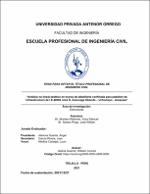Análisis no lineal estático en muros de albañilería confinada para pabellón de infraestructura de I.E.40092 José D. Zuzunaga Obando – Uchumayo - Arequipa

Ver/
Descargar
(application/pdf: 198.8Kb)
(application/pdf: 198.8Kb)
Fecha
2022Autor(es)
Montero Reforme, Victor Manuel
Santos Pingo, José William
Metadatos
Mostrar el registro completo del ítemResumen
El actual informe correspondiente al trabajo de investigación, denominado:
“ANÁLISIS NO LINEAL ESTÁTICO EN MUROS DE ALBAÑILERÍA CONFINADA
PARA PABELLÓN DE INFRAESTRUCTURA DE I.E.40092 JOSÉ D. ZUZUNAGA
OBANDO – UCHUMAYO - AREQUIPA”, se concentró en la aplicación de un método
de análisis no-lineal para determinar la respuesta estructural del pabellón en
mención.
El colegio I.E. 40092 José Domingo Zuzunaga Obando consta de seis pabellones, de
los cuales el Bloque 1 fue construido en el año 2016 y corresponden al modelo
arquitectónico tipo Sistémico INFES 780 nuevo. El sistema en la dirección X-X es de
pórticos, resistido únicamente por columnas de sección TEE y vigas, y un sistema de
albañilería confinada para la dirección Y-Y, como se indica en la descripción de la
arquitectura.
Anteriormente, se han utilizado diferentes y distintos métodos de análisis lineal para
evaluar diferentes tipos de estructuras existentes, y se ha determinado que la
mayoría de las estructuras de armazón de hormigón y, en algunos casos, la
mampostería de carga sufrirá daños considerables en casos severos de terremotos.
Para realizar un correcto análisis no lineal es necesario ingresar al diseño elástico y
lineal del edificio, debido a que se desarrolló utilizando el programa de cómputo
ETABS V.19, en concordancia con las normas sismorresistente E-030 y Albañilería
E-070, de nuestro Reglamento Nacional de Edificaciones.
Teniendo en cuenta los lineamientos del cálculo y método Pushover se calculó el
análisis no lineal estático en ambos ejes principales del Bloque 1, para ello se ha
empleado modelos inelásticos que distribuyen la plasticidad a lo largo de los
elementos estructurales analizados, debido a que estos son modelos más
sofisticados que proporcionan mayor información de cada fibra del elemento
estructural, para realizar el modelo no lineal se utilizó como herramienta el software
ix
Etabs19 teniendo en cuenta que para el eje X-X elementos tipo “frame” de igual
manera para los muros de albañilería confinada del eje Y-Y los elementos tipo
“Links”, donde para efectos de cálculo realizaremos las verificaciones con los niveles
de sismo dados por el ATC – 40 conjuntamente con los niveles de desempeños,
dados por La Propuesta del Comité VISION 2000 (SEAOC, 1995), teniendo en
consideración que para el Sismo Raro se considera como Sismo de diseño y con
respecto al sismo muy raro será equivalente con el sismo máximo.
Obteniendo finalmente el desempeño sísmico de un sismo de diseño y uno máximo
para la dirección de análisis “Y” según el comité VISION 2000 (SEAOC, 1995).
Además de los desplazamientos espectrales del pabellón de infraestructura de la
I.E.40092 José D. Zuzunaga Obando, en la dirección de análisis “Y” y así
recomendar consideraciones a tener en cuenta después de aplicado el Análisis No
Lineal Estático The current report corresponding to the research work, called: ““ANÁLISIS NO
LINEAL ESTÁTICO EN MUROS DE ALBAÑILERÍA CONFINADA PARA PABELLÓN
DE INFRAESTRUCTURA DE I.E.40092 JOSÉ D. ZUZUNAGA OBANDO –
UCHUMAYO - AREQUIPA““, focused on the application of an analysis method not -
linear to determine the structural response of the pavilion in question.
The I.E. 40092 José Domingo Zuzunaga Obando consists of six pavilions, of which
Block 1 was built in 2016 and correspond to the new systemic INFES 780
architectural model. The system in the X-X direction is of frames, resisted only by
TEE section columns and beams, and a confined masonry system for the Y-Y
direction, as indicated in the architecture description.
Previously, different and different linear analysis methods have been used to evaluate
different types of existing structures, and it has been determined that most concrete
frame structures and in some cases load-bearing masonry will suffer considerable
damage in severe cases. of earthquakes.
To perform a correct non-linear analysis, it is necessary to enter the elastic and linear
design of the building, since it was developed using the ETABS V.19 computer
program, in accordance with the E-030 and E-070 seismic resistant standards, of our
National Building Regulations.
Taking into account the guidelines of the calculation and Pushover method, the static
non-linear analysis was calculated in both main axes of Block 1, for this inelastic
models have been used that distribute the plasticity along the analyzed structural
elements, because these are More sophisticated models that provide more
information on each fiber of the structural element. To make the non-linear model, the
Etabs19 software was used as a tool, taking into account that for the XX axis “frame”
elements in the same way for the confined masonry walls of the Y axis and “Links”
xi
type elements, where for calculation purposes we will carry out the verifications with
the earthquake levels given by ATC - 40 together with the performance levels, given
by the VISION 2000 Committee Proposal (SEAOC, 1995), having in consideration
that for the Rare Earthquake it is considered as a design earthquake and with respect
to the very rare earthquake it will be equivalent to the earthquake or maximum.
Finally obtaining the seismic performance of a design earthquake and a maximum
one for the analysis direction ““Y““ according to the VISION 2000 committee (SEAOC,
1995). In addition to the spectral displacements of the infrastructure pavilion of the
I.E. 40092 José D. Zuzunaga Obando, in the direction of analysis ““Y““ and thus
recommend considerations to take into account after applying the Static Nonlinear
Analysis
Colecciones
- Ingeniería Civil [1302]

